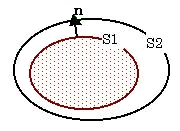Relationship between Nodal Force Method and Maxwell's Stress Method
- TOP >
- Analysis Examples by Functions (List) >
- Relationship between Nodal Force Method and Maxwell’s Stress Method
Summary
The nodal force method employed by EMSolution and the conventionally used Maxwell stress surface integration method may seem different, but they are closely related.
Explanation
First, both methods use the same Maxwell stress tensor $T_{ij}$. In the nodal force method, the electromagnetic force (i-directional component) at each node $n$ is obtained by integrating the Maxwell stress using equation (1). In Eq. (1), $w_n$ is the normal shape function of node $n$. $w_n$ is a function such that it is 1 at node $n$ and 0 at all other nodes and has a non-zero value only in the finite element with node $n$. Therefore, the integration of Eq. (1) is performed only in the element coupled to node $n$.
$$f=-\int T_{ik}\frac{\partial \omega_n}{\partial x_k} d\Omega (1)$$
Consider a magnetic material or conductor whose surface is surrounded by $S1$ as shown in Fig. 1. We also consider a surface $S2$ with only one finite element layer outside. The nodal forces in the object and on the surface are added together to obtain the total force.
The transformation as in Eq. (2) implies that the Maxwell stresses are integrated over the surface. In Eq. (2), $\omega$ can be expressed as in Eq. (3), but when the sum is performed for $S1$ and its interior nodes, it becomes 0 for $S1$ and its interior, 0 for $S2$ and its exterior, and an interpolated function in between. The spatial derivative of $\omega$ is 0 inside $S1$ and outside $S2$. Therefore, the integral in Eq. (2) is the integral in the region bounded by $S1$ and $S2$, and if $S1$ and $S2$ are very close, it is the surface area integral. In this way, the nodal force method can be thought of as averaging and integrating the Maxwell stress between $S1$ and $S2$. The Maxwell stress method, on the other hand, is a surface integral in the plane between $S1$ and $S2$. Assuming that $S1$ and $S2$ are very close and there is no calculation error, the nodal force method is equivalent to the Maxwell stress method.
$$\sum_{n}f_{ni} = -\int T_{ik}\frac{\displaystyle \partial \biggl( \sum_n \omega_{n} \biggr) }{\displaystyle \partial x_{k}}d\Omega = \int_{S1-S2}T_{ik} \nabla_{k}\omega d\Omega \cong \int T_{ik}n_{k}dS (2)$$
$$\omega = \sum_{n} \omega_n (3)$$
Considering the above, it is clear that in the nodal force method, the Maxwell stresses inside magnetic and other materials are not related to the total force. Of course, the Maxwell stress method also does not relate to the total force. In the Maxwell stress method, the location of the integration plane is often an issue. In particular, if the plane of integration is placed near a magnetic material, the error can be large. This is because the local magnetic field on the surface is integrated, and the error in the calculation of the local magnetic field may have a large effect. In the case of nodal forces, the error is averaged within the element, although it is only one layer, so it is thought to have a smaller effect. However, it is still considered more accurate to define the upper $S1$ plane away from the surface of the magnetic material, even in the case of nodal force. The distribution of the nodal force shows that in many cases the force also appears in the air region. In particular, it is larger in the region near the corner points. This should not appear if there is no magnetic field analysis error. As in the case of the Maxwell stress method, it is expected that the accuracy of the total force will be improved if the integration region is extended from magnetic materials, etc. If you want to obtain the total force only, you may understand from the above method that it does not matter to extend the region in such a way. The $S1$ surface above allows you to choose an area of integration other than the surface of magnetic materials, etc. (See “Improvement of electromagnetic force analysis”). A feature of the nodal force method is that, unlike the Maxwell stress method, local forces acting on an object can be obtained. Such local forces are considered to be important when deformation of magnetic and other materials becomes a problem. When only the total force or torque is an issue, the nodal force method is basically the same as the Maxwell stress method.
The rest of this page is for members only.
Analysis Examples by Functions
Electromagnetic force
©2020 Science Solutions International Laboratory, Inc.
All Rights reserved.



